Analys
Buying EUAs on the cheap will likely be one of the great opportunities of 2024

There are certainly bearish forces at work in the EUA market currently. Spot-wise, yes, but current forward price curve dynamics also creates a bearish pressure. Not the least from the utility side which normally is the big forward buyer of EUAs. They can now buy back previous forward hedges which where they locked in positive forward power margins. The can now instead reverse these which means that they instead of buying EUAs forward will sell EUAs forward.


That said, the MSR mechanism in the EUA market basically ensures that any surplus EUA above 833 million ton in the TNAC (Total Number of Allowances in Circulation) is wiped out within 2-3 years. The medium term EUA market fundamentals in 2026/27 and beyond is thus mostly untouched of what is going on right now. Forward 2026/27 and onward fundamentals are thus still as strong as they were previously which calls for a minimum price of EUR 100/ton or more by that time-horizon.
The question is what will be the catalyst which will turn this around to bullish price action instead of current bearish price action. A return to positive, forward clean dark and clean spark spreads is one. Economic revival in Europe as nat gas prices now have come down almost to the real average gas price level from 2010 to 2019 is another. Strong buying from shipping as they have no free allocations on their hands and will need every single EUA they buy in the years to come. But also industry will need increasingly more EUAs in the years to come and could utilize the current slump in EUA prices. Investors could also dive in at price levels seen ”too low” versus medium-term fundamental prices. Though hedge funds rarely have time to wait 2-3 years for a revival. But at some point the difference between the EUA spot price and what is considered a fair EUA price level (given politics and forward EUA fundamentals) become too big and too tempting to resist for both speculators and users of EUAs
Every year has unique opportunities in different types of assets, equities, currencies etc. We think that one of the great opportunities in 2024 when looked upon in hindsight, will be cheap EUAs. Thus those in need for EUAs in the years ahead should bid their time and pay attention to the opportunity currently playing out in the EU carbon market.
Since 17 January the front-month EUA price has ranged between an intraday low of EUR 59.12/ton and an intraday high of EUR 64.05/ton and with an average of closes of EUR 61.4/ton. The stabilization in the EUA price seems strongly related to the price development in the front-year TTF nat gas price which has stabilized at around EUR 32/MWh during the exact same period following a sharp price decline since early October last year.
The front-year TTF nat gas contract has stabilized at around EUR 32/MWh and the average year 2025 EUA price has stabilized for now around EUR 61/ton.

But the EUA price may have halted around the EUR 60/ton mark for other reasons as well. One is that when politicians tightened up the EUA market with backloading (2014) and MSR (2019) the EUA price rallied on its own merits and ahead of the Coal-to-Gas differentials all the way up to EUR 60/ton in 2021. In September 2021 however the C-t-G differentials (implied price of EUAs by marginal power market dynamics in an EUA market which is not too tight and not too loose) rallied ahead and above the EUA price due to the rally in nat gas prices. This then helped to drive the EUA price yet higher. The EUA price is now however back down at the crossover price of EUR 60/ton from September 2021 at which the EUA price previously was able to reach on its own merits (political tightening).
The average EUA front-year price in EUR/ton vs. the implied front-year C-t-G differential with 41% efficient coal and 54% efficient nat gas. The difference between the efficiency of 41% to 54% is not much different than the often used 36% vs 49%.
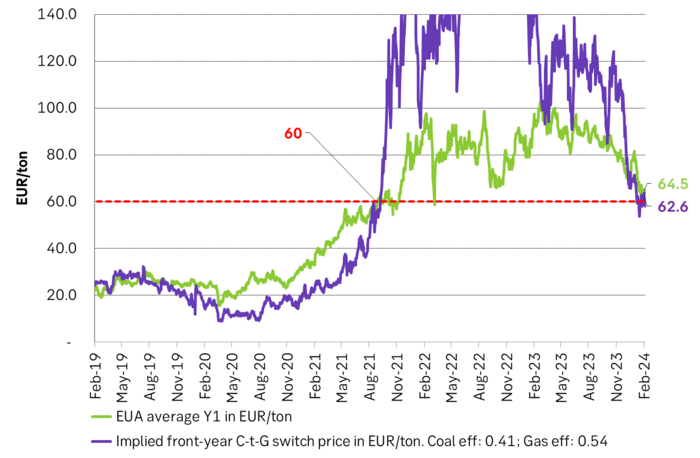
The EUA price also seems to follow the front-year C-t-G differentials quite closely while the discrepancies widen out further out on the curve. Thus a further sharp decline in the front-year TTF nat gas price is probably needed dynamically to drive the EUA price yet lower.
The EUA price seems to be anchored to the front-year TTF nat gas price as well as the front-year Coal-to-Gas differentials. But further out on the curve the latter widens out. Either because of increasing market tightness or simply due to curve structures. There are no support from C-t-G differentials in the current forward curves for 2026 and 2027.
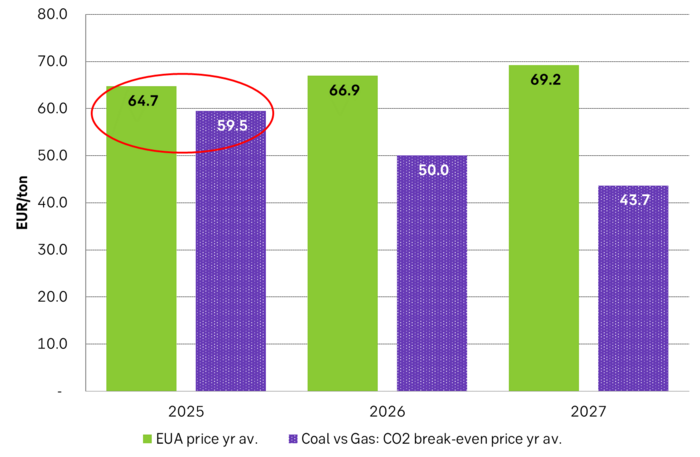
A serious element of weakness in the EUA market currently is that current forward clean power margins are negative. I.e. there is likely very limited amount of forward hedging by utilities as it doesn’t make sense for utilities to lock-in negative forward margins. Utilities are normally a large source of forward buying of EUAs and now there is probably close to nothing. And maybe even the opposite: Utilities may reverse previously entered hedges where they locked in forward positive margins and now instead can buy them back at favorable negative levels.
On a forward basis it costs more to produce power with Coal+CO2 or Gas+CO2 than it is possible to sell the power at on a forward basis.
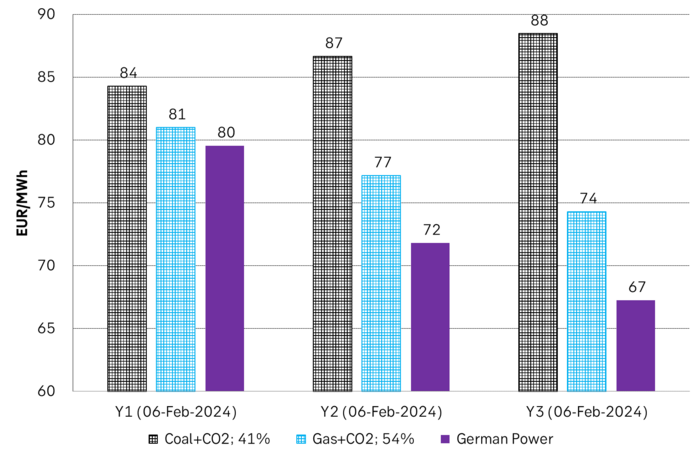
The following graph shows a ”utility hedging incentive index” which when positive indicates positive, clean forward coal and gas power margins with a weighting of 75%, 50% and 25% on the nearest Yr1, Yr2 and Yr3. Very strong and positive forward power margins since Jan 2019. The index crossed below the EUR 5/MWh margin October last year and now sits at a massive negative EUR 7.8/MWh at which Utilities are incentivised to revers their previous hedges and buy back previously sold power and then sell coal, gas and EUAs.
The EUA price vs. SEB’s Utility forward hedging incentive index. Now very negative. Potentially feeds EUA sales into the market from the Utility side.

There are thus certainly bearish forces at work in the EUA market currently. Both spot-wise but also current forward price curve dynamics creates a bearish pressure. Not the least from the utility side which normally is the big forward buyer of EUAs.
That said, the MSR mechanism in the EUA market basically ensures that any surplus EUA above 833 million ton in the TNAC (Total Number of Allowances in Circulation) is wiped out within 2-3 years. The medium term EUA market fundamentals in 2026/27 are thus mostly untouched of what is going on right now. Forward 2026/27 and onward fundamentals are thus still as strong as they were previously which calls for a minimum price of EUR 100/ton or more by that time-horizon.
The question is what will be the catalyst which will turn this around to bullish price action. Positive, forward clean dark and clean spark spreads is one. Economic revival in Europe as nat gas prices now have come down almost to the real average gas price level from 2010 to 2019. Strong buying from shipping as they have no free allocations on their hands and will need every single EUA the buy in the years to come. But also industry will need increasingly more EUAs in the years to come. Investors could also dive in at price levels seen ”too low” versus medium-term fundamental prices. Though hedge funds rarely have time to wait 2-3 years for a revival. But at some point the difference between the EUA spot price and what is considered a fair EUA price level (given politics and forward EUA fundamentals) become too big and too tempting to resist for both speculators and users of EUAs
Analys
More weakness and lower price levels ahead, but the world won’t drown in oil in 2026

Some rebound but not much. Brent crude rebounded 1.5% yesterday to $65.47/b. This morning it is inching 0.2% up to $65.6/b. The lowest close last week was on Thursday at $64.11/b.

The curve structure is almost as week as it was before the weekend. The rebound we now have gotten post the message from OPEC+ over the weekend is to a large degree a rebound along the curve rather than much strengthening at the front-end of the curve. That part of the curve structure is almost as weak as it was last Thursday.
We are still on a weakening path. The message from OPEC+ over the weekend was we are still on a weakening path with rising supply from the group. It is just not as rapidly weakening as was feared ahead of the weekend when a quota hike of 500 kb/d/mth for November was discussed.
The Brent curve is on its way to full contango with Brent dipping into the $50ies/b. Thus the ongoing weakening we have had in the crude curve since the start of the year, and especially since early June, will continue until the Brent crude oil forward curve is in full contango along with visibly rising US and OECD oil inventories. The front-month Brent contract will then flip down towards the $60/b-line and below into the $50ies/b.
At what point will OPEC+ turn to cuts? The big question then becomes: When will OPEC+ turn around to make some cuts? At what (price) point will they choose to stabilize the market? Because for sure they will. Higher oil inventories, some more shedding of drilling rigs in US shale and Brent into the 50ies somewhere is probably where the group will step in.
There is nothing we have seen from the group so far which indicates that they will close their eyes, let the world drown in oil and the oil price crash to $40/b or below.
The message from OPEC+ is also about balance and stability. The world won’t drown in oil in 2026. The message from the group as far as we manage to interpret it is twofold: 1) Taking back market share which requires a lower price for non-OPEC+ to back off a bit, and 2) Oil market stability and balance. It is not just about 1. Thus fretting about how we are all going to drown in oil in 2026 is totally off the mark by just focusing on point 1.
When to buy cal 2026? Before Christmas when Brent hits $55/b and before OPEC+ holds its last meeting of the year which is likely to be in early December.
Brent crude oil prices have rebounded a bit along the forward curve. Not much strengthening in the structure of the curve. The front-end backwardation is not much stronger today than on its weakest level so far this year which was on Thursday last week.

The front-end backwardation fell to its weakest level so far this year on Thursday last week. A slight pickup yesterday and today, but still very close to the weakest year to date. More oil from OPEC+ in the coming months and softer demand and rising inventories. We are heading for yet softer levels.

Analys
A sharp weakening at the core of the oil market: The Dubai curve

Down to the lowest since early May. Brent crude has fallen sharply the latest four days. It closed at USD 64.11/b yesterday which is the lowest since early May. It is staging a 1.3% rebound this morning along with gains in both equities and industrial metals with an added touch of support from a softer USD on top.

What stands out the most to us this week is the collapse in the Dubai one to three months time-spread.
Dubai is medium sour crude. OPEC+ is in general medium sour crude production. Asian refineries are predominantly designed to process medium sour crude. So Dubai is the real measure of the balance between OPEC+ holding back or not versus Asian oil demand for consumption and stock building.
A sharp weakening of the front-end of the Dubai curve. The front-end of the Dubai crude curve has been holding out very solidly throughout this summer while the front-end of the Brent and WTI curves have been steadily softening. But the strength in the Dubai curve in our view was carrying the crude oil market in general. A source of strength in the crude oil market. The core of the strength.
The now finally sharp decline of the front-end of the Dubai crude curve is thus a strong shift. Weakness in the Dubai crude marker is weakness in the core of the oil market. The core which has helped to hold the oil market elevated.
Facts supports the weakening. Add in facts of Iraq lifting production from Kurdistan through Turkey. Saudi Arabia lifting production to 10 mb/d in September (normal production level) and lifting exports as well as domestic demand for oil for power for air con is fading along with summer heat. Add also in counter seasonal rise in US crude and product stocks last week. US oil stocks usually decline by 1.3 mb/week this time of year. Last week they instead rose 6.4 mb/week (+7.2 mb if including SPR). Total US commercial oil stocks are now only 2.1 mb below the 2015-19 seasonal average. US oil stocks normally decline from now to Christmas. If they instead continue to rise, then it will be strongly counter seasonal rise and will create a very strong bearish pressure on oil prices.
Will OPEC+ lift its voluntary quotas by zero, 137 kb/d, 500 kb/d or 1.5 mb/d? On Sunday of course OPEC+ will decide on how much to unwind of the remaining 1.5 mb/d of voluntary quotas for November. Will it be 137 kb/d yet again as for October? Will it be 500 kb/d as was talked about earlier this week? Or will it be a full unwind in one go of 1.5 mb/d? We think most likely now it will be at least 500 kb/d and possibly a full unwind. We discussed this in a not earlier this week: ”500 kb/d of voluntary quotas in October. But a full unwind of 1.5 mb/d”
The strength in the front-end of the Dubai curve held out through summer while Brent and WTI curve structures weakened steadily. That core strength helped to keep flat crude oil prices elevated close to the 70-line. Now also the Dubai curve has given in.

Brent crude oil forward curves

Total US commercial stocks now close to normal. Counter seasonal rise last week. Rest of year?

Total US crude and product stocks on a steady trend higher.

Analys
OPEC+ will likely unwind 500 kb/d of voluntary quotas in October. But a full unwind of 1.5 mb/d in one go could be in the cards

Down to mid-60ies as Iraq lifts production while Saudi may be tired of voluntary cut frugality. The Brent December contract dropped 1.6% yesterday to USD 66.03/b. This morning it is down another 0.3% to USD 65.8/b. The drop in the price came on the back of the combined news that Iraq has resumed 190 kb/d of production in Kurdistan with exports through Turkey while OPEC+ delegates send signals that the group will unwind the remaining 1.65 mb/d (less the 137 kb/d in October) of voluntary cuts at a pace of 500 kb/d per month pace.

Signals of accelerated unwind and Iraqi increase may be connected. Russia, Kazakhstan and Iraq were main offenders versus the voluntary quotas they had agreed to follow. Russia had a production ’debt’ (cumulative overproduction versus quota) of close to 90 mb in March this year while Kazakhstan had a ’debt’ of about 60 mb and the same for Iraq. This apparently made Saudi Arabia angry this spring. Why should Saudi Arabia hold back if the other voluntary cutters were just freeriding? Thus the sudden rapid unwinding of voluntary cuts. That is at least one angle of explanations for the accelerated unwinding.
If the offenders with production debts then refrained from lifting production as the voluntary cuts were rapidly unwinded, then they could ’pay back’ their ’debts’ as they would under-produce versus the new and steadily higher quotas.
Forget about Kazakhstan. Its production was just too far above the quotas with no hope that the country would hold back production due to cross-ownership of oil assets by international oil companies. But Russia and Iraq should be able to do it.
Iraqi cumulative overproduction versus quotas could reach 85-90 mb in October. Iraq has however steadily continued to overproduce by 3-5 mb per month. In July its new and gradually higher quota came close to equal with a cumulative overproduction of only 0.6 mb that month. In August again however its production had an overshoot of 100 kb/d or 3.1 mb for the month. Its cumulative production debt had then risen to close to 80 mb. We don’t know for September yet. But looking at October we now know that its production will likely average close to 4.5 mb/d due to the revival of 190 kb/d of production in Kurdistan. Its quota however will only be 4.24 mb/d. Its overproduction in October will thus likely be around 250 kb/d above its quota with its production debt rising another 7-8 mb to a total of close to 90 mb.
Again, why should Saudi Arabia be frugal while Iraq is freeriding. Better to get rid of the voluntary quotas as quickly as possible and then start all over with clean sheets.
Unwinding the remaining 1.513 mb/d in one go in October? If OPEC+ unwinds the remaining 1.513 mb/d of voluntary cuts in one big go in October, then Iraq’s quota will be around 4.4 mb/d for October versus its likely production of close to 4.5 mb/d for the coming month..
OPEC+ should thus unwind the remaining 1.513 mb/d (1.65 – 0.137 mb/d) in one go for October in order for the quota of Iraq to be able to keep track with Iraq’s actual production increase.
October 5 will show how it plays out. But a quota unwind of at least 500 kb/d for Oct seems likely. An overall increase of at least 500 kb/d in the voluntary quota for October looks likely. But it could be the whole 1.513 mb/d in one go. If the increase in the quota is ’only’ 500 kb/d then Iraqi cumulative production will still rise by 5.7 mb to a total of 85 mb in October.
Iraqi production debt versus quotas will likely rise by 5.7 mb in October if OPEC+ only lifts the overall quota by 500 kb/d in October. Here assuming historical production debt did not rise in September. That Iraq lifts its production by 190 kb/d in October to 4.47 mb/d (August level + 190 kb/d) and that OPEC+ unwinds 500 kb/d of the remining quotas in October when they decide on this on 5 October.

-

 Nyheter4 veckor sedan
Nyheter4 veckor sedanMahvie Minerals i en guldtrend
-

 Analys4 veckor sedan
Analys4 veckor sedanVolatile but going nowhere. Brent crude circles USD 66 as market weighs surplus vs risk
-
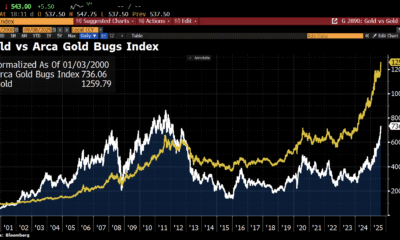
 Nyheter4 veckor sedan
Nyheter4 veckor sedanAktier i guldbolag laggar priset på guld
-

 Nyheter4 veckor sedan
Nyheter4 veckor sedanKinas elproduktion slog nytt rekord i augusti, vilket även kolkraft gjorde
-

 Nyheter4 veckor sedan
Nyheter4 veckor sedanTyskland har så höga elpriser att företag inte har råd att använda elektricitet
-
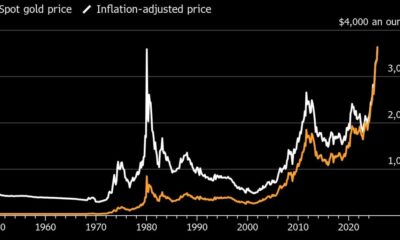
 Nyheter4 veckor sedan
Nyheter4 veckor sedanGuld når sin högsta nivå någonsin, nu även justerat för inflation
-
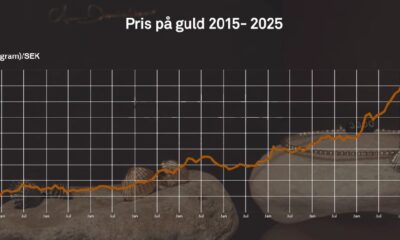
 Nyheter4 veckor sedan
Nyheter4 veckor sedanDet stigande guldpriset en utmaning för smyckesköpare
-

 Analys4 veckor sedan
Analys4 veckor sedanBrent crude ticks higher on tension, but market structure stays soft








